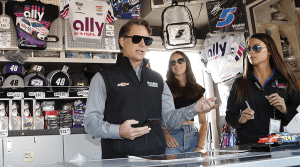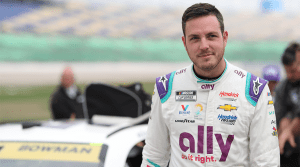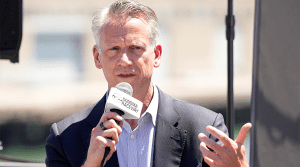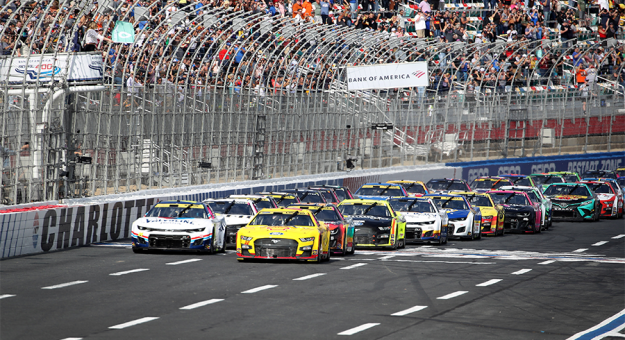CONCORD, N.C. — For three hours on Sunday at the Charlotte Motor Speedway ROVAL, NASCAR was able to do what it does best.
That is: stage a competitive race, create an intriguing storyline and finish with a completely unexpected ending that few saw coming.
It combined the high speeds of oval racing, with the Rugby-like contact of stock cars on a road course. It culminated with the stunning conclusion that the defending NASCAR Cup Series Kyle Larson, who entered the day appeared safely in the round of eight, was eliminated while Christopher Bell was the walk-off winner.
Bell had to win to get into the next round of the playoffs because he wasn’t going to make it on points.
Although the action didn’t happen until the very end, the previous 104 laps were run without a caution for an on-track incident that made the race look processional, the end of the race featured the storyline that has made NASCAR famous.
For three hours, all was right with NASCAR.
Leading into the race, however, NASCAR was embroiled in controversy, getting hammered from both the owners for an “unsustainable” business model and the drivers, who were part of a frank, open and intense safety discussion with NASCAR executives on Saturday morning.
Three drivers missed Sunday’s race including Kurt Busch and Alex Bowman with concussions and Cody Ware with a broken foot. That has raised major concerns about the safety of the NextGen car, where all of its primary pieces are made by a single supplier.
Drivers believe the cars are too rigid and even slower impact crashes have put them at risk of serious injury.
At a time when the focus for NASCAR and its teams should be on the playoffs, it has been blurred by the economic and negative impact.
First, let’s focus on the Race Team Alliance (RTA), a collection of the most powerful teams in NASCAR, which met with a group of reporters Friday to claim the economic model is “broken” and has no chance of long-term stability.
Team owners went public with their dispute with NASCAR over equitable revenue distribution.
“The economic model is really broken for the teams,” said Curtis Polk, who as Michael Jordan’s longtime business manager now holds an ownership stake in both the Charlotte Hornets and the two-car 23XI Racing team Jordan and Denny Hamlin field in NASCAR. “We’ve gotten to the point where teams realize the sustainability in the sport is not very long term.
“This is not a fair system.”
The RTA was formed in 2014, proving teams with a single voice in negotiations with the sanctioning body.
On Friday, a four-member subcommittee outlined their concerns at a Charlotte hotel, with Polk joined by Jeff Gordon, the four-time NASCAR champion and vice chairman of Hendrick Motorsports, RFK Racing President Steve Newmark, and Dave Alpern, the president of Joe Gibbs Racing.
Two teams have dominated the series the past seven seasons with Hendrick Motorsports and Joe Gibbs Racing winning six of the last seven Cup Series champions.

Gordon, who is now vice chairman at Hendrick Motorsports, said that team has not had a profitable season in years and will lose money again in 2022.
“I have a lot of fears that sustainability is going to be a real challenge,” Gordon said.
In June, Polk and the RTA gave NASCAR a seven-point plan on a new revenue sharing model.
“It sat there for months, and we told NASCAR we’d like a counteroffer,” Polk said.
According to the committee, they are willing to listen to other ideas including a Formula One type of spending cap.
“We are amenable to whatever gets us to a conceptual new structure,” Newmark said.
NASCAR responded to the RTA last week with a counteroffer of “a minimal increase in revenue and emphasis on cost-cutting,” Polk said.
The team alliance was unanimous in that the only place left to cut costs is layoffs.
“We’ve already had substantial cuts. We are doing more with less than we ever have in 30 years,” Alpern said.
In 2016 NASCAR adopted a charter system for 36 cars that is as close to a franchise model as possible in a sport that was founded by and independently owned by the France family. The charters at least gave the teams something of value to hold — or sell — and protect their investment in the sport.
But sponsorship is the key ingredient to these teams because it covers between 50 percent to 80 percent of the budgets for all 16 chartered organizations.
According to Newmark, the teams need “distribution from the league to cover our baseline costs,” he said.
The current charter agreement expires at the end of the 2024 season, the same time that NASCAR’s current television deals expire.
Although TV money is split between NASCAR, teams and the tracks, Polk said in terms of actual revenue produced by the sport 93 percent goes to NASCAR and the teams receive just 7 percent. He noted that in Formula One, all revenue is split 50-50 between the teams and series ownership.
“We have become full-time fundraisers,” Alpern said. “Instead of working on our business, we’re raising money just to exist.”
Polk said the teams will honor the charter agreements through 2024. But in negotiating a new charter agreement, the teams are demanding more.
“NASCAR is a money-printing machine,” Polk said. “But the teams and the drivers are the ones putting on the show.”
Just as important is the safety issue of the NextGen car. Drivers have complained all year that they are taking harder hits than they have ever felt in their careers. They don’t believe the cars absorb the impact, instead it sends the shock into the driver’s bodies.
NASCAR has tested potential adjustments to the car and revealed some of those findings to the drivers Saturday morning.
Some drivers regarded it as tense, others said the meeting with NASCAR was helpful.

“I feel much better,” Team Penske driver Joey Logano said after the meeting. “I feel like the meeting was very open and honest, which I feel like was necessary for all the drivers to get some things off their chest and their real concerns of what we’ve been going through and the experiences from inside the car.
“The frustrating part is it took way too long to have that meeting. That meeting should have happened Monday after Kurt’s crash, not waiting until Alex had his crash and at least hear us out. I’m not saying they weren’t working on it after Kurt’s crash, but the communication in person is so important.
“It’s the same thing when you’re talking about your life in a race car. It’s a little bit more important than that and we should be in person having those meetings a lot, not when we need to but before we need to, and I think those messages were heard loud and clear.
“There is a plan to try to help the rear impacts, but we need to stay focused on the rest of the car as well. There are a lot of other spots on the car we want to make better as well.”
Logano and many of the drivers have had to race without having the utmost confidence in the safety of the race car.
“We need to hold them honest now,” Logano said of NASCAR. “We got a meeting out of it, and I hope that’s not why we had the meeting is because a couple drivers got fired up in the media.
“I hope that’s not how we make change in our sport. I hope that’s not what we do. I think we’re better than that. I hope we’re better than that, but, like I said, sometimes your emotions will get, I don’t want to say the best of you, but sometimes you have to act out a little bit to make change happen and make sure you’re heard. It seemed like it definitely made something happen.
“It will be calm when the car is fixed.”
NASCAR President Steve Phelps appeared on the Peacock Pit Box on NBC before Sunday’s race for his only public comments on the safety issue of the NextGen and the economic issues brought up by the RTA.
“I thought the meeting was incredibly productive,” Phelps said. “The drivers were candid. We showed them a path forward on the rear of the car to take out some of the stiffness that exists and a bigger crush panel. But overall, we want to hear what they have to say. We care about what they say, and we’re going to continue to iterate on the car to make it safer.
“As great as the Driver Advisory Council has been, nothing is as good as having an all-driver meeting. We probably should have had one months ago to try to deal with the safety issues and what the drivers were feeling in the race car, so that’s on me. With that said, we’re going to have all-driver meetings for the rest of the year, so we’re going to do them on a weekly basis.”

Phelps indicated some potential fixes for the car were discovered during a crash test in Ohio last week.
“We had a crash test this week that crashed the rear of the car that created a bigger energy transfer into the back of the car vs. an energy transfer into the driver himself,” Phelps said. “So, both the head and head surrounding what happens there as well as things they’re feeling in their body. Because they’re taking hits that don’t look bad, but they’re feeling it. We understand they’re taking bigger hits.
“We want to make sure when we get to the Clash at the Coliseum that those drivers, when they strap in, know this car is going to be successful, and that we have made changes to the vehicle that are going to soften the blows that they’re taking.”
Despite the safety concerns about the NextGen car, it has certainly provided NASCAR with some of the most competitive racing in series history. There have been a record-tying 19 winners through 32 of 36 races.
“It has done everything it was supposed to do from a competition standpoint,” Phelps said. “Nineteen different winners, five first-time winners. We’ve had more green flag passes for the lead than we’ve ever had in the history of the sport since we’ve been doing Loop Data. And then passes throughout the field, the most we’ve had through 31 races, so we’re going to break that record, too. It’s just exciting.
“We had a meeting yesterday with one of our race teams, who some people consider to be back of the grid, and this principal said to me when I go to a racetrack, every single time, I believe we can win. I’ve never felt that before this Next Gen car, which is terrific. The underdog can come in here and win. You have a guy like Erik Jones at Petty GMS. We’re going to have that 20thå winner before the year is out, which would be terrific.”
Phelps also addressed the RTA’s assertion about the unsustainable economic business model.
“Race (fans) probably don’t really care about team profitability,” Phelps said. “I’m telling you race fans should care about team profitability because it creates better competition on the racetrack. That’s what fans care about.
“They don’t care about profitability of a race team, but it’s important because if teams don’t have the money to compete on the racetrack, we’re not going to have as good of racing. So, what we’re doing as the sanctioning body is moving forward, having discussions with the teams that would suggest that we are going to give teams more money from a revenue perspective.
“But we also need to work with the race teams on the expense side of things as well. There’s a balance there like any good business. Revenue in, expenses and look at profitability on the bottom line is critical, and so I’m confident we’re going to do that and get to a good place with hour race teams moving forward. We’re not going to talk about the negotiations here, but I’m excited about what that future is going to look like with our race teams.
“Because I do believe NASCAR and our race teams coming together. That’s a better thing in order to help promote the sport.”
At a time when NASCAR should be benefitting with positive promotion culminating with the NASCAR Cup Series championship on November 6 at Phoenix (Ariz.) Raceway, it must solve issues with two of its most vital partners – the owners and the drivers.
